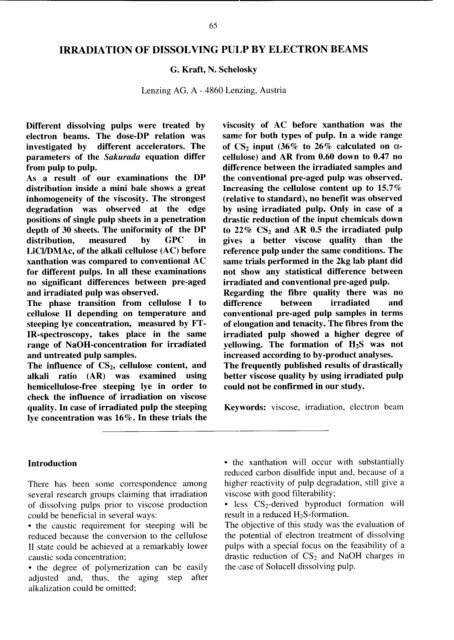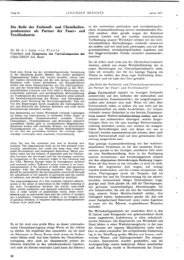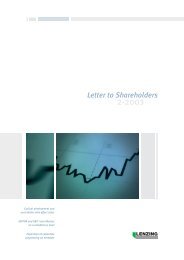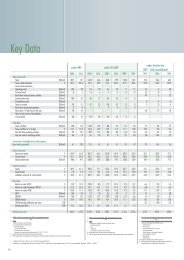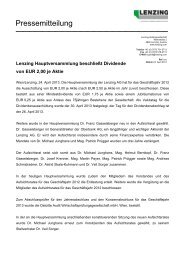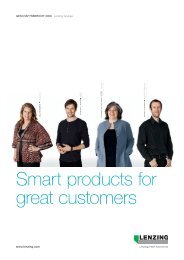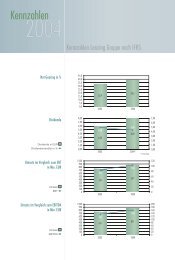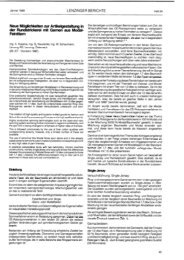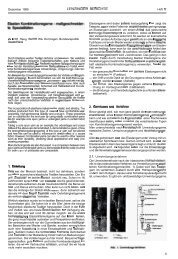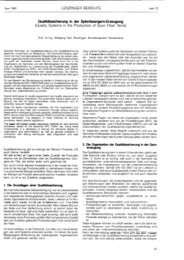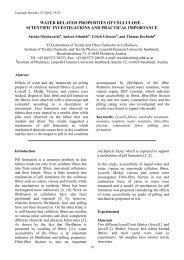irradiation of dissolving pulp by electron beams - Lenzing
irradiation of dissolving pulp by electron beams - Lenzing
irradiation of dissolving pulp by electron beams - Lenzing
Create successful ePaper yourself
Turn your PDF publications into a flip-book with our unique Google optimized e-Paper software.
6.5<br />
IRRADIATION OF DISSOLVING PULP BY ELECTRON BEAMS<br />
Different <strong>dissolving</strong> <strong>pulp</strong>s were treated <strong>by</strong><br />
<strong>electron</strong> <strong>beams</strong>. The dose-DP relation was<br />
invesugated <strong>by</strong> different accelerators. The<br />
Parameters <strong>of</strong> the Sakurada equation differ<br />
from <strong>pulp</strong> to <strong>pulp</strong>.<br />
As a result <strong>of</strong> our examinations the DP<br />
distribution inside a mini bale Shows a great<br />
inhomogeneity <strong>of</strong> the viscosity. The strongest<br />
degradation was observed at the edge<br />
positions <strong>of</strong> Single <strong>pulp</strong> sheets in a Penetration<br />
depth <strong>of</strong> 30 sheets. The uniformity <strong>of</strong> the DP<br />
distribution, measured <strong>by</strong> GPC in<br />
LiWDMAc, <strong>of</strong> the alkali cellulose (AC) before<br />
xanthation was compared to conventional AC<br />
for different <strong>pulp</strong>s. In all these examinations<br />
no significant differentes between pre-aged<br />
and irradiated <strong>pulp</strong> was observed.<br />
The Phase transition from cellulose 1 to<br />
cellulose 11 depending on temperature and<br />
steeping lye concentration, measured <strong>by</strong> FT-<br />
IR-spectroscopy, takes place in the same<br />
range <strong>of</strong> NaOH-concentration for irradiated<br />
and untreated <strong>pulp</strong> samples.<br />
The influence <strong>of</strong> CS2, cellulose content, and<br />
alkali ratio (AR) was examined using<br />
hemicellulose-free steeping lye in Order to<br />
check the influence <strong>of</strong> <strong>irradiation</strong> on viscose<br />
quality. In case <strong>of</strong> irradiated <strong>pulp</strong> the steeping<br />
lye concentration was 16%. In these trials the<br />
Introduction<br />
There has been some correspondence among<br />
several research groups claiming that <strong>irradiation</strong><br />
<strong>of</strong> <strong>dissolving</strong> <strong>pulp</strong>s Prior to viscose production<br />
could be beneficial in several ways:<br />
. the caustic requirement for steeping will be<br />
reduced because the conversion to the cellulose<br />
11 statle could be achieved at a remarkably lower<br />
caustic soda concentration;<br />
l the degree <strong>of</strong> polymerization tan be easily<br />
adjusted and, thus, the aging step after<br />
alkalization could be omitted;<br />
G. Kraft, N. Schelosky<br />
<strong>Lenzing</strong> AG, A - 4860 <strong>Lenzing</strong>, Austria<br />
viscosity <strong>of</strong> AC before xanthation was the<br />
same for both types <strong>of</strong> <strong>pulp</strong>. In a wide range<br />
<strong>of</strong> CIS2 input (36% to 26% calculated on a-<br />
cellulose) and AR from 0.60 down to 0.47 no<br />
differente between the irradiated samples and<br />
the conventional pre-aged <strong>pulp</strong> was observed.<br />
Increasing the cellulose content up to 15.7%<br />
(relaLtive to Standard), no benefit was observed<br />
<strong>by</strong> using irradiated <strong>pulp</strong>. Only in case <strong>of</strong> a<br />
drastic reduction <strong>of</strong> the input chemicals down<br />
to 22% CS2 and AR 0.5 the irradiated <strong>pulp</strong><br />
gives a better viscose quality than the<br />
reference <strong>pulp</strong> under the same conditions. The<br />
same trials performed in the 2kg lab plant did<br />
not show any statistical differente between<br />
irraldiated and conventional pre-aged <strong>pulp</strong>.<br />
Reg:arding the fibre quality there was no<br />
differente between irradiated and<br />
conventional pre-aged <strong>pulp</strong> samples in terms<br />
<strong>of</strong> elongation and tenacity. The fibres from the<br />
irraldiated <strong>pulp</strong> showed a higher degree <strong>of</strong><br />
yellowing. The formation <strong>of</strong> H2S was not<br />
increased according to <strong>by</strong>-product analyses.<br />
The frequently published results <strong>of</strong> drastically<br />
bettier viscose quality <strong>by</strong> using irradiated <strong>pulp</strong><br />
could not be confirmed in our study.<br />
Keywords: viscose, <strong>irradiation</strong>, <strong>electron</strong> beam<br />
l the xanthation will occur with substantially<br />
reduced carbon disulfide input and, because <strong>of</strong> a<br />
higber reactivity <strong>of</strong> <strong>pulp</strong> degradation, still give a<br />
viscose with good filterability;<br />
l less CS*-derived <strong>by</strong>product formation will<br />
result in a reduced H2S-formation.<br />
The objective <strong>of</strong> this study was the evaluation <strong>of</strong><br />
the potential <strong>of</strong> <strong>electron</strong> treatment <strong>of</strong> <strong>dissolving</strong><br />
<strong>pulp</strong>s with a special focus on the feasibility <strong>of</strong> a<br />
drastic reduction <strong>of</strong> CS* and NaOH charges in<br />
the case <strong>of</strong> Solucell <strong>dissolving</strong> <strong>pulp</strong>.
Economical considerations. . The price <strong>of</strong><br />
irradiated <strong>of</strong> <strong>pulp</strong> is composed <strong>of</strong> high costs <strong>of</strong><br />
botlh investment and Operation, the latter one<br />
mainly depending on expenses for electric<br />
power. From this Point <strong>of</strong> view, the <strong>irradiation</strong> <strong>of</strong><br />
<strong>pulp</strong> would become an economically interesting<br />
innovation only if it is possible to carry out the<br />
viscose process with drastically reduced input<br />
chemicals (22% CS*, AR: 0.5) without any<br />
impairment <strong>of</strong> the fiber quality.<br />
Experimental<br />
For the experiments at lab plant and Pilot plant,<br />
50 sheets (isostack) <strong>of</strong> Solucell 450 were<br />
irraldiated at STUDER AG with a 1OMeV<br />
Rhodotron TT300 accelerator built <strong>by</strong> IBA.<br />
The viscose quality was evaluated <strong>by</strong> PVC and<br />
KWP filter value (constant pressure) and particle<br />
i<br />
-<br />
I<br />
Irradiated Pulp fl2 kCy)<br />
BA: 10 MeV<br />
homogeneous nking <strong>of</strong> prllp chips<br />
Steeping lye concentratioe: 16%<br />
/ Viscose <strong>of</strong> the sanuz composition was prepared for irradiated and<br />
-.<br />
LAB PLANT<br />
Viscose Quality<br />
Viscose Rheology I<br />
- -----.~-~~--~ _-_- - - ---~~_<br />
66<br />
count. The viscose was also characterized <strong>by</strong><br />
rheological investigations and analysis <strong>of</strong><br />
<strong>by</strong>products, see Table 1 and Figure 1.<br />
No optimization <strong>of</strong> spinning conditions was done<br />
for these experiments.<br />
Table 1. Viscose composition for the experiments at lab<br />
plant and Pilot plant.<br />
Plant CS2 (%) AR Ce11 conc.<br />
Lab 36 0.6<br />
Lab 32 0.6<br />
Lab’ 28 0.55<br />
Lab 26 0.5<br />
Lab 22 0.5<br />
Lab 28 0.55<br />
Lab<br />
Pilot<br />
Figure 1. Experimental setup.<br />
--<br />
28<br />
22<br />
0.475<br />
0.5<br />
Standard<br />
Standard<br />
Standard<br />
Standard<br />
Standard<br />
Standard +<br />
15.6%<br />
Standard +<br />
15.6%<br />
Standard<br />
Con~entionai Ageiag<br />
Sieeping lye co~~~~~rati~a Standard<br />
-.--I--~ --.x .._““
Viscosity [ml/g]<br />
290 1 without aftertreatment<br />
260-<br />
Irrxhatwn Doiage: 12 kGy<br />
250L 0 - I - I - I - . . 1<br />
0 10 20 30 40 50<br />
Sheet Numher<br />
Figure :t. Intrinsic viscosity distribution within one mini<br />
bale: homogeneity <strong>of</strong> <strong>irradiation</strong> at a dosage <strong>of</strong> 12 kGy.<br />
In case <strong>of</strong> irradiated <strong>pulp</strong> the hemicellulose<br />
concentration in press lye was higher than in the<br />
conventional process (2.25 g/l versus 1.48 g/l).<br />
67<br />
Ball J?zLZ <strong>of</strong> viscose. As published, the ball fall <strong>of</strong><br />
viscose made from irradiated <strong>pulp</strong> should be<br />
lowel than that <strong>of</strong> viscose made from<br />
conventionally pre-aged <strong>pulp</strong>. Thus, it should be<br />
possible to increase the production capacity <strong>by</strong><br />
using a higher content <strong>of</strong> irradiated cellulose<br />
under retention <strong>of</strong> the same ball fall <strong>of</strong> the<br />
viscose as before. However, only at high<br />
celluliose content (115.6% <strong>of</strong> Standard) and very<br />
low alkali content a lower ball fall seemed to<br />
result from the use <strong>of</strong> irradiated <strong>pulp</strong> (Figure 3).<br />
There is no benefit in ball fall <strong>by</strong> using irradiated<br />
Pulp=<br />
Polytlispersity <strong>of</strong> AC. No differente regarding<br />
polydispersity between aging and <strong>electron</strong> beam<br />
treatment could be observed in the respective<br />
viscosity range (Figure 4).<br />
100% [ca 100% [CS 100% [ca 100% 100% 115.6% [CS2z 115.6% [cs2:<br />
360/0; ARZ 0.q 32v4 AR: 0.6) 280/0; AR: o.5.q [oi2:26%, AR [cs2:22%, AR BS, AR 0.55j 28%, AR:<br />
O-Tl Wl 0.47Sj<br />
2.6<br />
Figure 3. Ball fall <strong>of</strong> various compositions <strong>of</strong> viscose prepared from irradiated and pre-aged <strong>pulp</strong>;<br />
lab-plant trials. Ball fall corrected to target cellulose concentration.<br />
1.6<br />
400 300<br />
Intrinsic viscosity [mYg]<br />
Figure 4. Polydispersity vs. intrinsic viscosity <strong>of</strong> AC.
68<br />
Phase transition Cellulose I - Cellulose II. The networks under extreme conditions (CS2<br />
pha.se transition takes place in the same range <strong>of</strong> reduction, increase in cellulose) than reference<br />
Na0H: concentration for irradiated and untreated <strong>pulp</strong>. It has a higher potential for savings from<br />
<strong>pulp</strong> s amples . this Point <strong>of</strong> view.<br />
Rheology <strong>of</strong> Viscose Spinning Dope. Under Viscose from irradiated <strong>pulp</strong> under saving<br />
Standard conditions, irradiated <strong>pulp</strong> yields conditions is rheologically worse than one from<br />
rheologically worse viscose than reference <strong>pulp</strong>. reference <strong>pulp</strong> under Standard conditions.<br />
Under conditions <strong>of</strong> CS2 reduction and increase Quality <strong>of</strong> viscose. The <strong>of</strong>ten published results <strong>of</strong><br />
in cellulose, irradiated <strong>pulp</strong> yields rheologically drastically better viscose quality <strong>by</strong> using<br />
better viscose than reference <strong>pulp</strong>. Irradiated irradiated <strong>pulp</strong> could not be confirmed in our<br />
<strong>pulp</strong> seems to have a lower tendency <strong>of</strong> forming study <strong>of</strong> Solucell450.<br />
800<br />
700<br />
0 600<br />
L 500<br />
2<br />
P 400<br />
5 300<br />
-z<br />
200<br />
100<br />
0<br />
HFilter value [PVC] q Total particle volume[ppm]<br />
Fignre 5. Viscose quality. Trials made at lab plant with Standard cellulose concentration (average +/- 95,4% conf. interval).<br />
Filter value (higher is better) and total particle content at Standard cellulose content in viscose [CS,%/AR].<br />
IFilter value [PVC] q Total particle volume [ppm]<br />
pre aged - CS2: 28 % ; Irradiated - CS2: 28%; pre aged - CS2: 28%; Irradiated -CS2: 28%;<br />
AR: 0.55 AR: 0.55 AR: 0.475 AR: 0.475<br />
Figure 6. Viscose quality. Trials made at lab plant with Standard cellullose concentration (average +/- 95,4% conf. interval).<br />
Filter value (higher is better) and total particle content at 15.6% higher cellulose content in viscose [C,‘$%/AR].<br />
20<br />
18
In a wide range <strong>of</strong> CS2 input (36% to 26%<br />
calculated on a-cellulose) and AR from 0.60<br />
down to 0.47 no significant differente in viscose<br />
quality between the irradiated samples and the<br />
conventionally pre-aged <strong>pulp</strong> was observed.<br />
Upon increase <strong>of</strong> the cellulose content up to<br />
115.7% <strong>of</strong> Standard, no benefit was observed <strong>by</strong><br />
using irradiated <strong>pulp</strong>. Only in case <strong>of</strong> a drastic<br />
reduct-ion <strong>of</strong> the input chemicals down to 22%<br />
CS; and AR 0.5 the irradiated <strong>pulp</strong> gave a better<br />
viscose quality than the reference <strong>pulp</strong> under the<br />
same conditions (Figures 5 and 6). The same<br />
trials iperformed at the 2kg Pilot plant did not<br />
show any statistical differente between irradiated<br />
and conventionally pre-aged <strong>pulp</strong> (Table 2).<br />
B~JW&KLS. There seems to be a slight tendency<br />
to lower trithiocarbonate formation in the viscose<br />
made from the irradiated <strong>pulp</strong>.<br />
Fibre properties. Viscose <strong>of</strong> reduced CS2 content<br />
showed good spinning properties, the spinning<br />
conditions were not optimized. Tenacity and<br />
elonga.tion were not significantly influenced <strong>by</strong><br />
the use <strong>of</strong> irradiated <strong>pulp</strong>, the tendency is slightly<br />
better for aged <strong>pulp</strong>.<br />
Tenacity and elongation were significantly<br />
impaired <strong>by</strong> the reduction <strong>of</strong> CS2 Charge using<br />
Standard spinning conditions (Figure 7).<br />
69<br />
Brightness and yellowing <strong>of</strong> fibres were<br />
nega.tively influenced <strong>by</strong> both the use <strong>of</strong><br />
irrad.iated <strong>pulp</strong> and the reduction <strong>of</strong> CS2 Charge<br />
(Figure 8).<br />
Table 2. Results <strong>of</strong> trials at a Pilot plant [averagehange].<br />
conventional irradiated<br />
CS2 l%l Std. 22 Std. 22<br />
Alkali ratio Std. 0.5 Std. 0.5<br />
unfiltered viscose<br />
Filter value, PVC 452 252 393 1156 335 /IO3<br />
125 1167<br />
Filter value, 77 144 230 117169 123 139<br />
KWP 1230<br />
Total particle 12.4 28.3 18.6/17.1 22.1 /3.2<br />
volume [ppm] 17.8 140.0<br />
Time for 43 78 60 70<br />
filtration, min.<br />
viscose spinning dope<br />
Filter value, PVC 528 233 528 134 439 132<br />
/186 /121<br />
Filter value, 26112 47116 40115 43 145<br />
KWP<br />
Total particle 1.2 2.5 1.4 IO.5 1.3 IO.3<br />
volume [ppm] IO.6 11.8<br />
Ball fall [sec] 49 83 60 93<br />
Ripening ind., “H 14.7 6.5 15.9 7.8<br />
aged Standard irradiated aged 22% CS2; AR irradiated 22%<br />
Standard 0.5 CS2; AR 0.5<br />
Figure 7. Tenacity and elongation <strong>of</strong> fibers at standarcl spinning conditions (Pilot plant trials).
1<br />
-<br />
&Q<br />
75<br />
E 70<br />
lQ5<br />
-E<br />
60<br />
55<br />
50<br />
45<br />
aged standard irradiated aged 22% CS2; AR irradiated 22%<br />
Standarcl 0.5 (32; AR 0.5<br />
Figve 8. Brightness <strong>of</strong> unbleached fibers at standard spinning conditions (pilot plant hi&).<br />
Conclusion References<br />
Electron beam treatment <strong>of</strong> <strong>pulp</strong> slightly<br />
improves viscose filterability at a very low level<br />
<strong>of</strong> CS2 charge (lab plant).<br />
However, this improvement is not liirge enough<br />
to justify the additional costs <strong>of</strong> <strong>electron</strong> beam<br />
treatment. The higher hemicellulose conteat in<br />
the steeping lye and the enhanced yellowing <strong>of</strong><br />
the fibers are further arguments against <strong>electron</strong><br />
beam treatment <strong>of</strong> <strong>dissolving</strong> <strong>pulp</strong>.<br />
The <strong>of</strong>ten published results <strong>of</strong> drastically better<br />
viscose quality <strong>by</strong> using irradiated <strong>pulp</strong> could not<br />
be confirmed in our study <strong>of</strong> Solucell450.<br />
[ 11 Fisher, K.; Goldberg, W.; Wilke, M. Lanz.<br />
BeE 1985,59,32.<br />
[Z] Rajagopal, S. et al. "Enhancement <strong>of</strong><br />
Cellulose Reactivity in Viscose Production<br />
Using Electron F'rocessing Technology"'<br />
Viscose Chemistry Seminat, Stockholm,<br />
1994.<br />
[3] Rajagopal, S. PETAS Seminar, Hamburg,<br />
1995.<br />
[4] Rajagopal, S. Cellulosic Man-Made Fibre<br />
Summit, Singapore, 1997.<br />
[5] Stavtsov, A.; Cassel, A. Cellulosic Man-<br />
Made Fibre Sumit, Singapore, 1997.<br />
[6]<br />
Schleicher, H.; Bomneister, B.; Voges, M.<br />
Cellulosic -Made Fibre Summit,<br />
Singapore, 1997.


